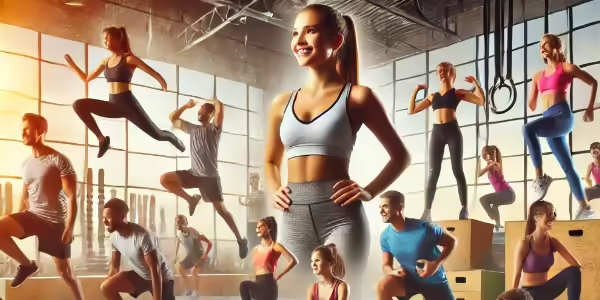
Top 10 Fitness Challenges to Try in 2025
Challenges bring excitement to your workouts and help you stay committed and disciplined. This blog will explore the top 10 fitness challenges for a successful health journey in 2025. Let’s delve into the world of fitness challenges and discover how you can get stronger, fitter, and healthier this year! Embrace the journey toward wellness!
This blog will analyse the top 10 fitness challenges for a thriving fitness journey in 2024. Let’s dive into the world of fitness challenges and discover how you can get stronger, fitter, and healthier this year!
30-Day Plank Challenge
Why Try It?
The plank is one of the most effective exercises for building core strength. It engages multiple muscle groups, including your shoulders, back, and abs, making it a fantastic full-body workout.
How It Works:
Kick off your plank challenge by holding a plank for 20 seconds on Day 1. Every day, you will increase your time by 5 to 10 seconds. By the end of 30 days, you will be able to hold a plank for up to 5 minutes. This challenge is designed for beginners and fitness enthusiasts determined to bolster their core strength, stability, and posture.
Tips for Success:
- Keep your body in a straight line from head to heels.
- Engage your core and glutes to avoid sagging.
- Breathe steadily and avoid holding your breath.
- Step Count Challenge
Why Try It?
Walking is one of the most comfortable and effective ways to stay active, especially if you’re starting. The step count challenge encourages you to increase your daily steps, promoting cardiovascular health and overall well-being.
How It Works:
Set a goal, like 8,000 or 10,000 steps daily, and gradually increase it over the month. Use a smartphone app or fitness tracker to observe your progress. The idea is to boost your activity levels, making it an excellent option for those who prefer a low-impact fitness routine.
Tips for Success:
- Take the stairs instead of the elevator.
- Walk during phone calls or while listening to podcasts.
- Join a walking group for added motivation.
- Squat Challenge
Why Try It?
If you want to build lower body strength, tone your legs, and boost your metabolism, the squat challenge is for you. Squats target your glutes, quads, hamstrings, and core, making them a powerhouse exercise.
How It Works:
Start with 50 squats on Day 1 and increase by five squats each day. By Day 30, you’ll complete over 200 squats in one session! This challenge not only builds muscle but also improves balance and flexibility.
Tips for Success:
- Keep your back straight and chest lifted.
- Push through your heels, not your toes.
- Add variations like jump squats or pulse squats to keep it interesting.
Push-Up Challenge
Why Try It?
The push-up is a classic exercise for building upper body strength, targeting the chest, shoulders, triceps, and core. The push-up challenge can help you build muscle and endurance, whether a beginner or a pro.
How It Works:
Begin with five push-ups on Day 1, adding two more each day. By the end of the challenge, you can perform 50 push-ups in one go. You can modify this challenge by doing knee push-ups if you’re a beginner or trying variations like diamond push-ups for added difficulty.
Tips for Success:
- Maintain a straight line from your head to your heels.
- Lower your body until your chest almost touches the floor.
- Keep your elbows close to your body to protect your shoulders.
Couch to 5K Challenge
Why Try It?
If you’ve always wanted to start running but needed to know where to begin, the Couch to 5K challenge is your answer. It’s designed for beginners and gradually increases your running time until you can run 5 kilometres.
How It Works:
The program typically spans 9 weeks, with three sessions per week. You start with intervals of walking and running, slowly reducing the walking segments and increasing the running time. By the end of the challenge, you’ll be able to run 5K without stopping.
Tips for Success:
- Invest in the proper pair of running shoes.
- Warm up with a 5-minute walk before each run.
- Focus on your breathing and pace yourself.
10-Minute Sweat Challenge
Why Try It?
Have a busy schedule? The 10-minute sweat challenge is ideal for those with limited time. High-intensity interval Training (HIIT) helps burn fat, improve cardiovascular health, and boost metabolism in just a few minutes.
How It Works:
Dedicate 10 minutes a day to a high-intensity workout that includes exercises like burpees, mountain climbers, and jumping jacks. The key is to go all out with minimal rest between workouts.
Tips for Success:
- Keep a timer handy to track intervals.
- Stay hydrated and warm up before starting.
- Modify the exercises to suit your fitness level.
Yoga Flexibility Challenge
Why Try It?
Yoga is great for flexibility, stress reduction, and mental well-being. The 30-day yoga challenge focuses on daily stretching and poses to enhance flexibility and balance.
How It Works:
Each day, dedicate 15-30 minutes to practicing yoga. Start with beginner poses like Downward Dog and Child’s Pose, gradually progressing to advanced stretches. This challenge is ideal for improving your range of motion and releasing muscle tension.
Tips for Success:
- Practice yoga in a quiet space free from distractions.
- Use props like blocks and straps to enhance your practice.
- Focus on your breath to deepen the stretch.
Ab Challenge
Why Try It?
For those looking to sculpt their midsection, the 30-day ab challenge is a must-try. It targets your core muscles, helping you achieve that toned stomach.
How It Works:
Perform ab-focused exercises like crunches, leg raises, and bicycle kicks each day. Start with ten reps of each exercise and increase by five reps every 3 days. By the end of the month, you’ll notice improved core strength and definition.
Tips for Success:
- Focus on proper form to avoid neck strain.
- Engage your abs throughout the entire movement.
- Pair with a healthy diet for best results.
Office Fitness Challenge
Why Try It?
Sitting for long periods can be detrimental to health. The office fitness challenge is designed to keep you active even at work.
How It Works:
Incorporate quick exercises throughout your workday. This could include desk push-ups, chair squats, or sitting around the office every hour. It’s a great way to stay active and break up the monotony of your day.
Tips for Success:
- Set reminders on your phone to get up and move.
- Encourage your colleagues to join in for added motivation.
- Use a standing desk if possible to reduce sitting time.
Beginner’s Home Fitness Challenge
Why Try It?
If you prefer the comfort of home workouts, this challenge is perfect for you. It focuses on bodyweight exercises that can be done with minimal equipment.
How It Works:
Spend 20 minutes daily doing squats, lunges, push-ups, and planks. Gradually improve the intensity of your workouts by adding more repetitions or incorporating weights to enhance strength, endurance, and overall fitness.
Tips for Success:
- Set a designated workout space in your home.
- Stay consistent by scheduling your workouts at the same time each day.
- Track your progress to stay motivated.
Benefits of Fitness Challenges
- Accountability: Knowing you have a set plan can help you stay committed.
- Variety: Challenges add new exercises to your routine, keeping things exciting.
- Goal Setting: They provide clear objectives, making it easier to stay motivated.
- Community Support: Many challenges have online groups or apps where participants share their progress, creating a sense of camaraderie.
Final Thoughts
Fitness challenges are a fun, engaging, and effective way to jumpstart your fitness journey or add some spice to your existing routine. Whether you’re looking to build strength, improve flexibility, or stay active, there’s a challenge. So, choose a challenge that aligns with your fitness goals, grab a friend to join you, and prepare to transform your health in 2025
Are you ready to take on the challenge? Let’s make 2025 your fittest year.

